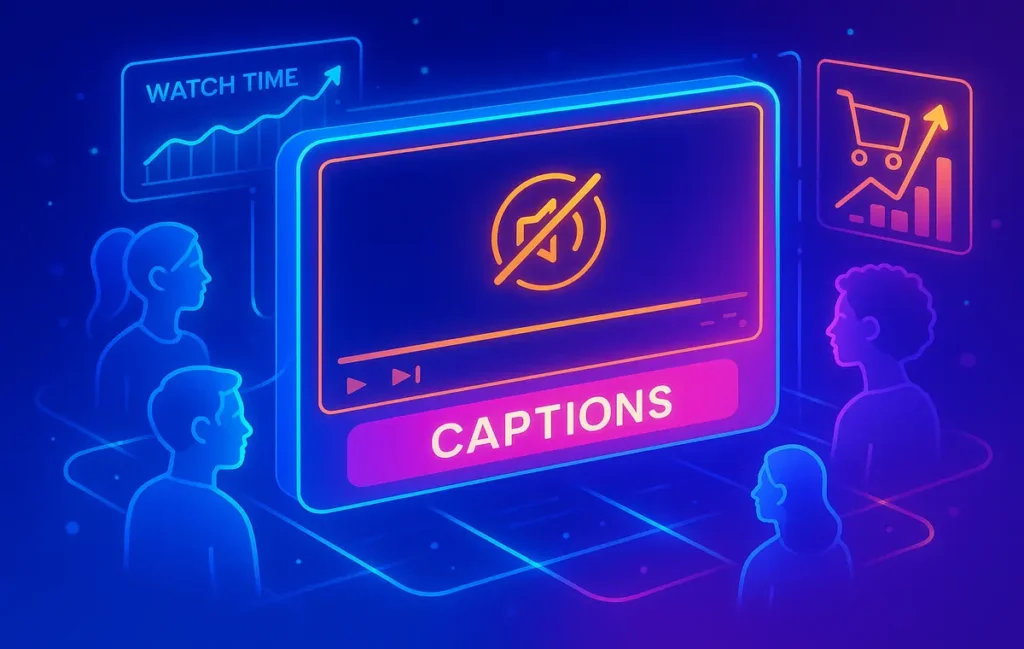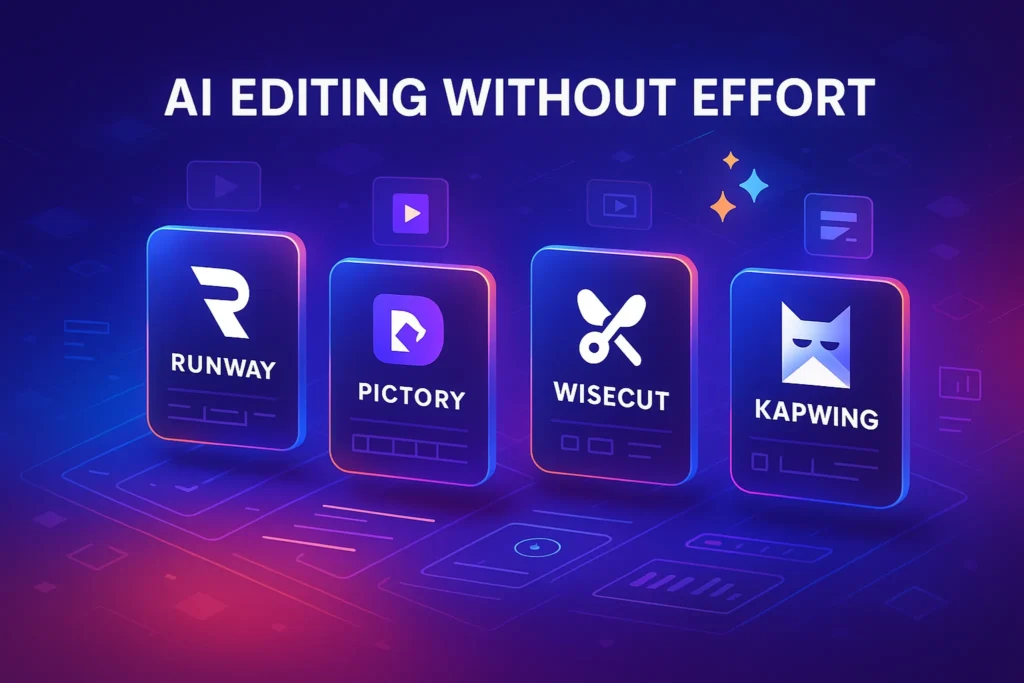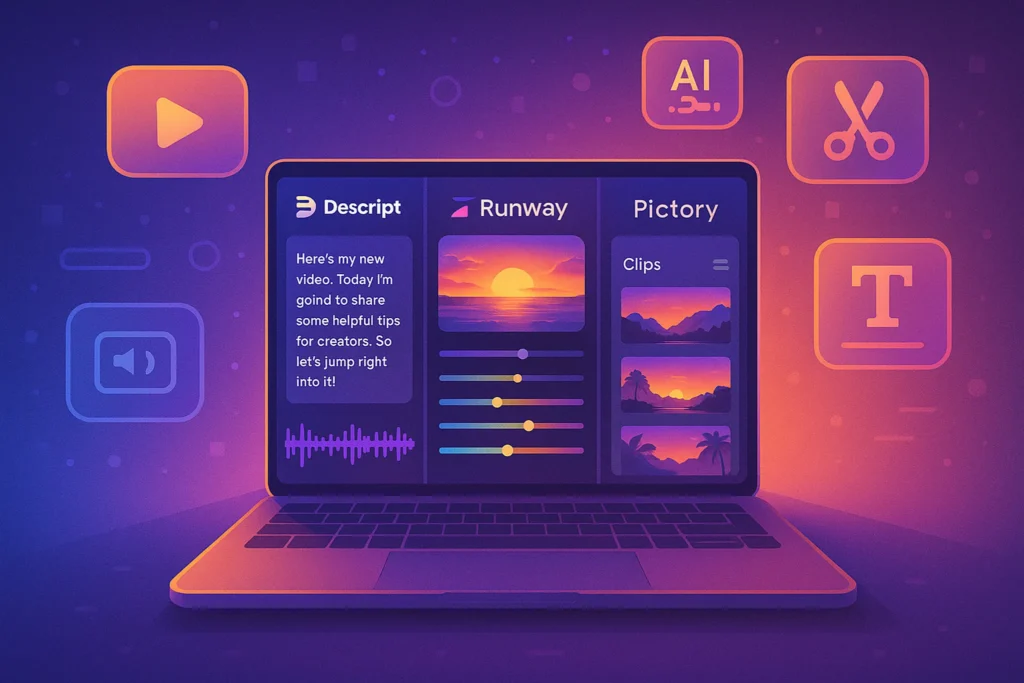🎯 Intro
Over 90% of videos on mobile are watched without sound. That means if your videos don’t include captions, most of your audience isn’t truly experiencing your message. In 2025, captions and accessibility are no longer “nice extras”—they’re mission-critical tools for video marketing.
Whether you’re publishing short-form TikToks, YouTube tutorials, or paid video ads, subtitles extend your reach, improve retention, and even drive sales. At NerdChips, we’ve already explored how creators automate YouTube editing and scale with AI video editing tools. Now, let’s focus on captions—the overlooked growth lever that turns silent viewers into engaged customers.
🔍 Why Captions & Accessibility Matter
Captions matter because they close gaps: between creators and deaf/hard-of-hearing audiences, between brands and global customers, and between video content and search engines.
From a viewer’s perspective, captions make content more inclusive. Around 466 million people worldwide live with disabling hearing loss. Adding captions opens your content to an audience many brands ignore. But accessibility isn’t the only reason—data shows captions improve engagement for everyone.
Facebook’s internal tests revealed that video ads with captions increased view time by 12% on average. TikTok found that captions boosted completion rates because viewers could follow along even in noisy or muted environments. For global audiences, captions also bridge language gaps, helping non-native speakers understand your content more clearly.
Accessibility is fast becoming an ROI-driven decision. Captions don’t just help people—they help brands.
🛠️ How Subtitles Drive Engagement & Sales
Subtitles act as invisible conversion drivers. Here’s how:
-
Boosting ad performance. Captions clarify your message instantly, even when autoplay is muted. This increases click-through rates on video ads.
-
Improving retention. YouTube creators report longer watch times when captions are present. Retention is one of YouTube’s key ranking factors, which directly supports growth.
-
Helping SEO. Platforms index captions, turning your spoken words into searchable metadata. This means keywords in your subtitles may help videos rank in Google and YouTube search.
-
Building trust. Captions convey professionalism and inclusivity, reinforcing your brand reputation. Customers are more likely to buy when they feel represented.
💡 Nerd Tip: Always use both burnt-in captions (visible in the video) and SRT/VTT files (uploadable subtitle files). Burnt-in captions maximize accessibility, while SRT files give you the SEO and multi-platform advantages.
📊 Tools for Captioning & Subtitles in 2025
The landscape of captioning tools has evolved dramatically. AI caption generators are now accurate enough for most creators, but manual review remains essential.
-
Veed.io: A creator-friendly platform with auto-captions, subtitle styling, and one-click exports.
-
Descript: Excellent for editing transcripts alongside video, making captions part of the editing process itself.
-
Kapwing: Great for social creators who need fast, visually engaging subtitles.
-
YouTube Auto-Subtitles: Convenient but not perfect. Accuracy is often around 70–80%, requiring careful editing.
-
AI Caption Generators: New models integrate with editing workflows, reducing time while improving sync.
Many of these tools are now bundled into best-in-class AI video editing suites, giving creators one-stop workflows for editing, captioning, and exporting.
🚀 Implementation Guide
To maximize captions’ value, creators should think strategically:
Step 1: Choose your captioning tool. AI solutions save time, but manual editing ensures accuracy. Tools like Descript blend both worlds.
Step 2: Review and sync. Automatic captions often misinterpret accents or technical terms. Human editing is essential for brand credibility.
Step 3: Add keywords naturally. Captions are indexed. If you’re producing a video about “AI marketing tools,” include that phrase when it’s spoken. This aligns video SEO with brand strategy.
Step 4: Export in multiple formats. SRT for YouTube, VTT for web players, and burnt-in captions for social media. Multi-format support ensures reach across platforms.
Step 5: Test across platforms. Subtitles behave differently on TikTok, YouTube, and LinkedIn. Preview before publishing to avoid broken formatting.
By approaching captions as part of the video editing process, not an afterthought, you’ll build consistency across your workflow.
⚠️ Challenges & Solutions
Like any marketing tactic, captioning has hurdles. AI-generated captions, while faster, often lack nuance. Technical terms, brand names, or slang may be mistranscribed, creating awkward experiences. The solution? AI + human review.
Manual captioning is accurate but expensive at scale. A hybrid model—auto-generation followed by light human editing—is the sweet spot for most creators.
For multilingual accessibility, machine translation tools help, but native proofreading ensures quality. Brands expanding globally should invest in local review, particularly for paid campaigns.
Even cost-sensitive creators can implement captions by starting with auto-generated subtitles in YouTube Studio, editing them for accuracy, and then repurposing across channels. This workflow aligns with strategies we covered in How to Edit Videos Like a Pro on a Budget.
📈 ROI of Accessibility
The ROI case for captions is compelling. Videos with captions consistently outperform those without:
-
Higher watch time. Facebook found captioned ads saw a 12% increase in view time.
-
Better engagement. TikTok completion rates jump when captions are present.
-
Improved conversions. Advertisers report up to 15% higher sales lift on campaigns with accessible captions.
-
Enhanced brand image. Inclusive practices build goodwill and credibility, which translates into customer loyalty.
Accessibility is no longer a compliance checkbox. It’s a direct growth lever for video marketing strategies.
⚡ Make Your Videos Accessible—Unlock Higher Watch Time & Conversions
Explore AI-powered tools like Veed.io, Descript, and Kapwing. Blend AI speed with human review to publish accurate, engaging captions that boost ROI.
🔎 Historical Context of Subtitles
Subtitles were once a simple utility. In the TV era, they existed primarily to help foreign audiences or support accessibility for hearing-impaired viewers. On DVDs, they were often just a language add-on. But the shift to digital platforms completely transformed their purpose.
Today, subtitles are not only about translation or accessibility—they’re part of a growth strategy. When mobile became the dominant medium, autoplay without sound became the default. Suddenly, captions were no longer optional—they were the only way to communicate with audiences who scrolled with muted feeds. In this sense, subtitles evolved from a “support tool” into a frontline marketing lever.
📊 Data-Backed Benchmarks
Numbers tell the real story of why captions matter:
-
Facebook reported that captions increased average view time by 12% in video ads.
-
YouTube advertisers observed a 15% boost in CTR when captions clarified muted messages.
-
Global brands adding multi-language subtitles saw 20–25% growth in international engagement because videos became instantly understandable across markets.
These aren’t minor improvements—they’re significant performance lifts that impact ROI directly. If you’re investing in video, not captioning it is leaving measurable money on the table.
🧩 Multi-Language Strategy
One of the most underutilized aspects of captioning is multi-language support. For global brands, subtitles serve as both translation and localization. Adding Spanish, French, or Mandarin captions instantly broadens reach, opening up new audiences without creating entirely new video versions.
AI translation tools make it fast and cost-effective, but human review remains critical. Automated systems often mishandle idioms or technical terms. A hybrid approach—AI for first drafts, native editors for polish—creates subtitles that are both scalable and accurate.
This strategy is especially effective for international YouTube channels, global e-commerce brands, or SaaS companies targeting multiple regions. Captions are cheaper than full dubbing but often just as effective at building trust.
🏭 Team & Workflow Angle
In professional marketing teams, captioning has become a structured part of workflow rather than an afterthought. Here’s how leading organizations integrate it:
-
Creative teams write initial scripts with captions in mind, ensuring readability.
-
SEO specialists optimize subtitle text to capture keywords for video indexing.
-
Localization teams adapt subtitles into multiple languages for global campaigns.
This integration ensures that subtitles are treated as a strategic marketing asset, not just a compliance box. When workflows embed captions from the start, videos launch faster, reach wider audiences, and deliver stronger results.
🔮 Accessibility & Legal Compliance
Beyond marketing, captions are also a compliance issue. In the United States, the Americans with Disabilities Act (ADA) requires video content from public entities and many businesses to be accessible. In the EU, the Web Accessibility Directive sets similar standards.
Failure to provide captions can expose organizations to lawsuits, fines, and reputational damage. For enterprise brands, accessibility isn’t just about inclusivity—it’s about legal and brand safety. In 2025, more platforms and regulators are tightening enforcement, making captioning essential not only for growth but also for risk management.
📈 AI & Future of Captioning
The future of captioning is AI-driven. Already, platforms like YouTube Live generate real-time captions for broadcasts. Emerging tools are pushing this further—AI models now provide real-time multilingual captions with impressive accuracy.
Looking ahead, AR glasses and immersive devices may layer captions directly onto the world around us, making spoken language universally understandable. For marketers, this means captions won’t just be a feature—they’ll be an expectation across every platform and format.
This evolution ties directly into trends like those in 7 Emerging AI Marketing Tools You’ve Never Tried, where accessibility and automation merge into mainstream workflows.
🛡 Mini Case Studies & Quotes
Captions’ impact is also visible in real-world stories.
A D2C fashion brand reported doubling CTR on TikTok ads after adding bold, styled captions. Before captions, viewers skipped muted videos; with captions, engagement spiked.
On X, one user shared: “I watch 100% of my videos muted. If there are no captions, I scroll instantly.” This kind of anecdotal evidence reinforces what the data already shows: captions are the bridge between silent consumption and actual engagement.
📬 Want More Smart Video Marketing Insights?
Join our free newsletter and get weekly strategies on video marketing, AI editing, and accessibility—delivered straight to your inbox. No fluff. Just actionable insights from NerdChips.
🔐 100% privacy. No noise. Just high-impact content for creators and marketers from NerdChips.
🧠 Nerd Verdict
Captions are no longer optional—they’re central to success in video marketing. They increase accessibility, extend your audience, boost watch time, improve SEO, and drive measurable sales lifts.
Every video without captions loses opportunities: missed viewers, lower retention, and weaker brand perception. In 2025, captions aren’t just an accessibility feature—they’re a conversion lever. NerdChips believes brands that embrace accessibility will lead the next wave of video-first marketing.
❓ FAQ: Nerds Ask, We Answer
💬 Would You Bite?
Would you risk losing half your audience by skipping captions?
Or will you embrace accessibility to boost watch time, reach, and sales? 👇
Crafted by NerdChips for creators and marketers who want every word of their videos to be heard—even in silence.



